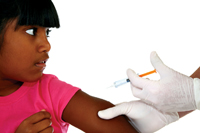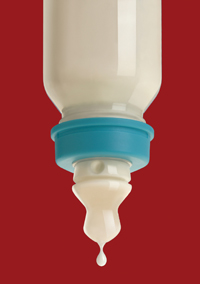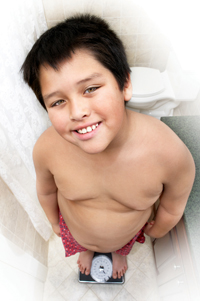 Get that shot
Get that shot
Have your kids gotten all of their before-school inoculations? Those now include one for chicken pox, thanks to a new Washington state law that requires kids entering kindergarten and sixth grades get that vaccine — or provide schools with proof that they’ve already had the “pox.” According to the Washington State Department of Health, the vaccine is recommended for teens who haven’t had chickenpox or haven’t been previously vaccinated. Chicken pox spreads easily and can have serious complications — including skin infections, pneumonia and meningitis. Washington is one of the last states to make the chicken pox vaccine mandatory for schoolchildren.
Meningitis awareness
Our state doesn’t require kids to get vaccinated against meningitis, but if Mount Vernon resident Lori Buher has her way, one day it will. After Buher’s son battled meningococcal disease, she began raising awareness about meningitis. She’s also trying to persuade state lawmakers to include the meningitis vaccine as one of the immunization requirements for junior high school students. The disease is a serious bacterial infection; early symptoms resemble the flu and may include sudden onset of fever, headache and stiff neck. Adolescents are at increased risk and account for nearly 30 percent of the cases in this country.
More tests for newborns
Your newborn baby — if she’s born in this state — will be tested for 15 new disorders, thanks to recently added screening tests. This means all Washington babies will now be tested for 25 conditions at birth. The state’s testing includes all but one of the disorders recommended by the March of Dimes. More information on newborn screening is available on the Department of Health’s Web site.
The latest on baby bottles
The Food and Drug Administration (FDA) has deemed baby bottles safe. FDA scientists say the small amounts of bisphenol A that leach out of food containers are not a threat to infants or adults.  Bisphenol A is used to make plastic, shatterproof bottles as well as canned food. Meanwhile, environmental groups criticized the agency’s conclusions, claiming it relies on industry-funded studies.
Bisphenol A is used to make plastic, shatterproof bottles as well as canned food. Meanwhile, environmental groups criticized the agency’s conclusions, claiming it relies on industry-funded studies.
New guidelines target food allergies
Thanks to a relatively young organization called FAI (Food Allergy Initiative) Northwest, the state superintendent’s office will develop guidelines to help manage the risk of food allergies in Washington state schools. FAI Northwest was founded two years ago by a group of local parents hoping to heighten food allergy awareness and raise funds to find a cure. In addition to supporting research, the organization trains and educates staff about food allergies at schools, day-care centers and camps. For information, go to www.foodallergyinitiative.org and click on FAI NW.
How’s your child’s hearing?
The American Speech-Language-Hearing Association (ASHA) says kids who are at risk for hearing loss should be screened often to make sure they’re hearing well. At-risk children include those with chronic ear infections and kids who have a family history of hearing loss. All kids ages 5–18 should be checked for healthy hearing when they first enter school, then annually through third grade. The ASHA suggests more screenings in seventh and 11th grades. If you think your child may have a speech, language, or hearing problem, contact an ASHA-certified audiologist or speech-language pathologist.
Still the Greatest Show on (cyber) Earth
Your child can interact (well, virtually) with clowns, acrobats and high-wire artists and get fit at the same time. If that sounds like fun, it is. Ringling Bros. and Barnum & Bailey has introduced a national youth fitness program called CircusFit that’s designed to teach kids fun ways to stay active, fit and healthy. The program — find it at www.CircusFit.com — is geared for kids grades 2 through 5 and features interactive lessons that take about 20 minutes to complete. Also on the site are games, workout suggestions, eating tips and “character building” advice. It may turn your child’s computer time into a three-ring circus, but that could be a good thing.
 What you should know about obesity
What you should know about obesity
- Approximately 30.3 percent of children (ages 6 to 11) are overweight and 15.3 percent are obese. For adolescents (ages 12 to 19), 30.4 percent are overweight and 15.5 percent are obese.
- Among children and teens, almost 9 million are overweight — triple the number since 1980. More than 10 percent of children between the ages of 2 and 5 are overweight — double the proportion since 1980.
- More boys (32.7 percent) are overweight than girls (27.8 percent). In adolescents, the numbers even out and nearly the same number of females (30.2 percent) are overweight as males (30.5 percent).
Source: CircusFit
—Linda Morgan


